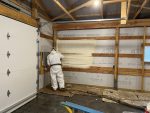This Wednesday the Pole Barn Guru answers reader questions about the need for a vapor barrier, the longevity of properly treated posts, and the better spray foam between open and closed cell.
 DEAR POLE BARN GURU: Hello Sir, hoping you can help answer a question I cannot get a straight answer on. Currently building a 30x40x14 building and have the walls and roof house wrapped with Kelly Clark Block It. Steel is going on the building now. I just ordered steel for interior ceiling and trying to figure out if I should add a vapor barrier to bottom of truss first. Thoughts? MATT in ILLINOIS
DEAR POLE BARN GURU: Hello Sir, hoping you can help answer a question I cannot get a straight answer on. Currently building a 30x40x14 building and have the walls and roof house wrapped with Kelly Clark Block It. Steel is going on the building now. I just ordered steel for interior ceiling and trying to figure out if I should add a vapor barrier to bottom of truss first. Thoughts? MATT in ILLINOIS
DEAR MATT: Block it is wrong product for under roof steel. It allows moisture to pass through and be trapped between it and roof steel. As long as you do not blow in cellulose, you should not need a ceiling vapor barrier.
DEAR POLE BARN GURU: I bought a pole barn that has been retrofitted to a house. The posts are in ground. I’m worried about future resell and longevity of the post. Also, I’m in a cold climate and wonder if a proper footing would help with heating. Is there any good way to retrofit from in ground post to stem wall or something similar. I’m sure it’s all possible if money was not an issue. I’m looking for an economical solution. Thanks!! NICK in WEST LIBERTY
 DEAR NICK: Properly pressure preservative treated columns (UC-4B) should outlast anyone alive on our planet today, especially in climates (such as yours) not prone to termite infestations. As for improving ability to heat – dig a trench around outside of building at least two feet wide and two feet deep. Invest in 2′ x 8′ (or 4′ x 8′ to be cut in half lengthwise), R-10 EPS insulation boards. Attach vertically to exterior side of pressure treated splash plank with top of insulation even with top of interior concrete slab. Run another 2′ horizontally out away from building at bottom of vertical. Any portion of vertical insulation above backfill will need to be protected from UV rays. This should keep your slab from getting so cold, as well as help to avoid frost heave. If you are in an area prone to burrowing rodents, you should further protect insulation https://www.hansenpolebuildings.com/2021/03/rascally-rodents/
DEAR NICK: Properly pressure preservative treated columns (UC-4B) should outlast anyone alive on our planet today, especially in climates (such as yours) not prone to termite infestations. As for improving ability to heat – dig a trench around outside of building at least two feet wide and two feet deep. Invest in 2′ x 8′ (or 4′ x 8′ to be cut in half lengthwise), R-10 EPS insulation boards. Attach vertically to exterior side of pressure treated splash plank with top of insulation even with top of interior concrete slab. Run another 2′ horizontally out away from building at bottom of vertical. Any portion of vertical insulation above backfill will need to be protected from UV rays. This should keep your slab from getting so cold, as well as help to avoid frost heave. If you are in an area prone to burrowing rodents, you should further protect insulation https://www.hansenpolebuildings.com/2021/03/rascally-rodents/
 DEAR POLE BARN GURU: I am trying to decide whether to go with open cell or closed cell spray foam on my bare metal pole barn walls. I will be enclosing the walls with some material, most likely plywood. What are your opinions regarding the pros/cons (is one or the other worse for corrosion, condensation, other pertinent factors, etc.) of the two foam approaches? Thanks so much! TERRI in CHESTER
DEAR POLE BARN GURU: I am trying to decide whether to go with open cell or closed cell spray foam on my bare metal pole barn walls. I will be enclosing the walls with some material, most likely plywood. What are your opinions regarding the pros/cons (is one or the other worse for corrosion, condensation, other pertinent factors, etc.) of the two foam approaches? Thanks so much! TERRI in CHESTER
DEAR TERRI: Open cell spray foam allows moisture to pass through and condense against steel cladding. I would not recommend it being used unless a two-inch thick layer of closed cell was first applied, then add open cell for extra R value (and to deaden sound).
 “Hi there, I have a 40×104 pole barn. It has 16 foot sidewalls with rafters every 4 foot on center for snow load. The entire interior of the building is spray foamed to about 1 inch thickness. I want to install a ceiling under the rafters and put in r 38 insulation on top. I know that there were ridge vents when the building was put together, however the guy who spray foamed sprayed over the vents. I plan to clean that out. My question is are just those ridge vents enough for ventilation or do I need additional intake vents. The building does not have an overhang or soffits so they would not be easy to install. Do you have any suggestions?”
“Hi there, I have a 40×104 pole barn. It has 16 foot sidewalls with rafters every 4 foot on center for snow load. The entire interior of the building is spray foamed to about 1 inch thickness. I want to install a ceiling under the rafters and put in r 38 insulation on top. I know that there were ridge vents when the building was put together, however the guy who spray foamed sprayed over the vents. I plan to clean that out. My question is are just those ridge vents enough for ventilation or do I need additional intake vents. The building does not have an overhang or soffits so they would not be easy to install. Do you have any suggestions?” Installing spray foam during winter months is more challenging, but one can increase potential for a successful installation in several ways. One way to successfully apply spray foam insulation in winter, despite less than ideal conditions, is to use a winter blend of spray foam. Closed-cell spray foams can be formulated into a winter blend allowing them to withstand colder environmental and surface temperatures. If you want to install open-cell spray foam insulation, however, it’s not possible to create a winterized formulation. Instead, you must create a suitable environment at installation site (e.g. add heat to building).
Installing spray foam during winter months is more challenging, but one can increase potential for a successful installation in several ways. One way to successfully apply spray foam insulation in winter, despite less than ideal conditions, is to use a winter blend of spray foam. Closed-cell spray foams can be formulated into a winter blend allowing them to withstand colder environmental and surface temperatures. If you want to install open-cell spray foam insulation, however, it’s not possible to create a winterized formulation. Instead, you must create a suitable environment at installation site (e.g. add heat to building). Besides not being Code conforming, there is an issue of cost. Your suggested product provided at The Home Depot will provide a volume equal to five 80 pound bags of concrete (or 1/10th of a yard) for $37.63 or $376.30 per yard. With pre-mix concrete prices being roughly $100 a yard, concrete being Code conforming and not contributing to decay any more than would high density foam, it seems to me to be a no brainer.
Besides not being Code conforming, there is an issue of cost. Your suggested product provided at The Home Depot will provide a volume equal to five 80 pound bags of concrete (or 1/10th of a yard) for $37.63 or $376.30 per yard. With pre-mix concrete prices being roughly $100 a yard, concrete being Code conforming and not contributing to decay any more than would high density foam, it seems to me to be a no brainer. Highly unlikely, as from the research I have been doing there appear to be no chemicals in the spray foam which would react with the steel or the galvanized or galvalume protective layer over the bare material. Most steel roofing is factory finish painted, which adds yet another barrier surface in the interior primer paint coat which further isolates the steel from the spray foam.
Highly unlikely, as from the research I have been doing there appear to be no chemicals in the spray foam which would react with the steel or the galvanized or galvalume protective layer over the bare material. Most steel roofing is factory finish painted, which adds yet another barrier surface in the interior primer paint coat which further isolates the steel from the spray foam.





